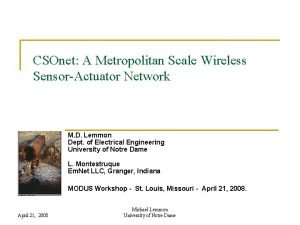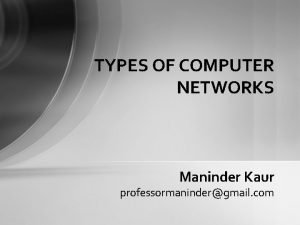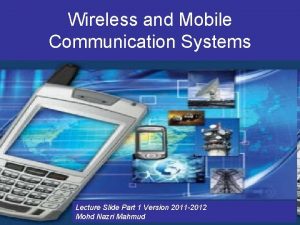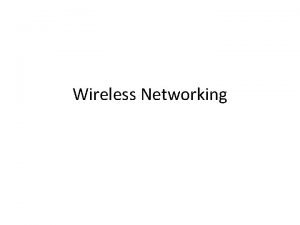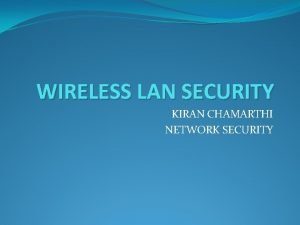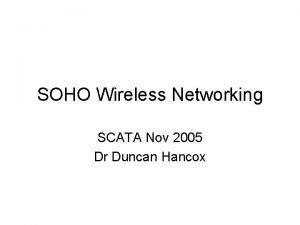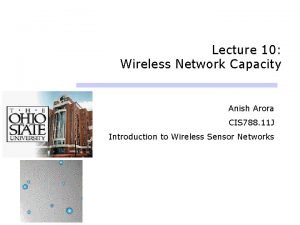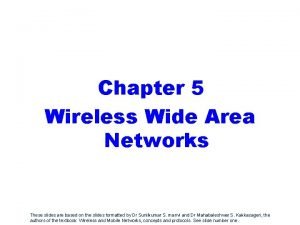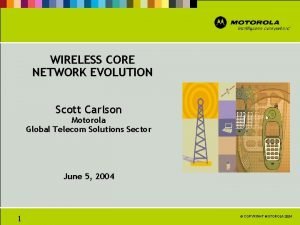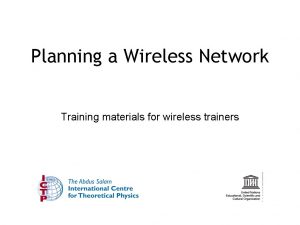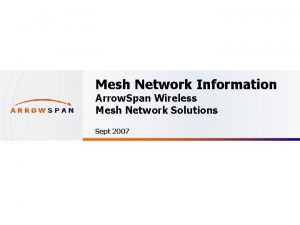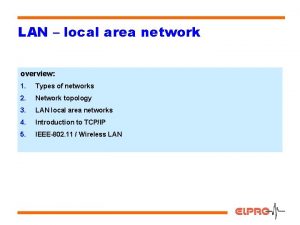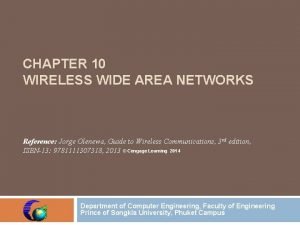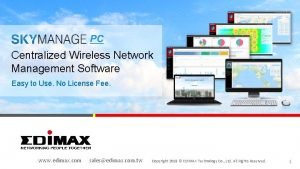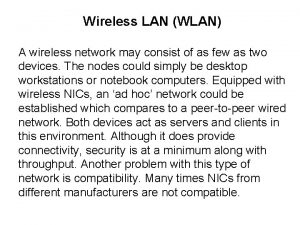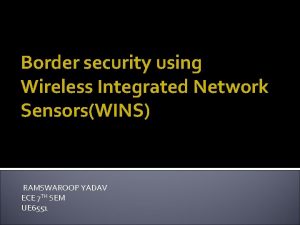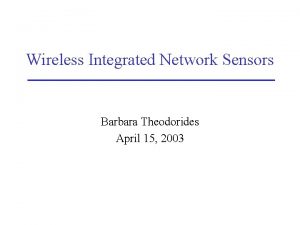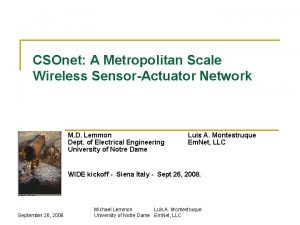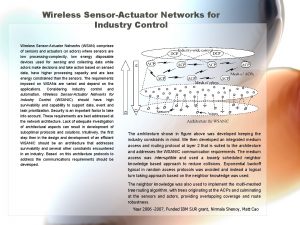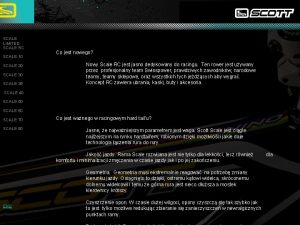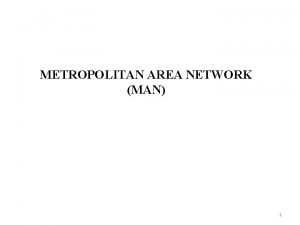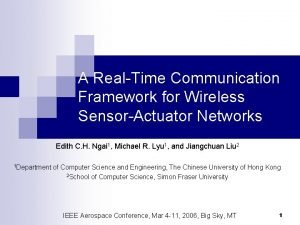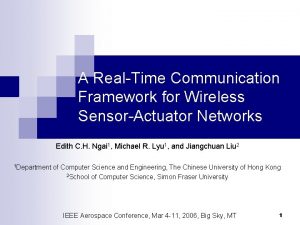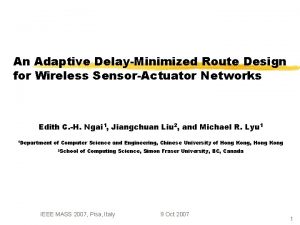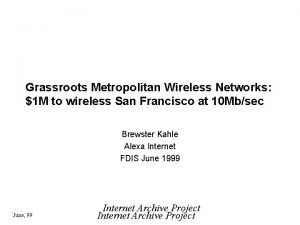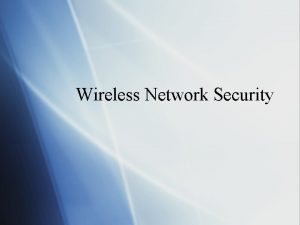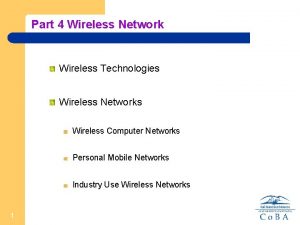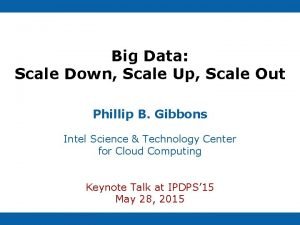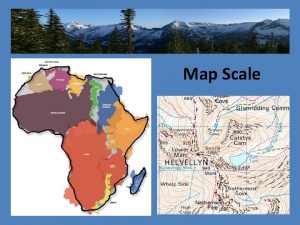CSOnet A Metropolitan Scale Wireless SensorActuator Network M





















- Slides: 21

CSOnet: A Metropolitan Scale Wireless Sensor-Actuator Network M. D. Lemmon Dept. of Electrical Engineering University of Notre Dame L. Montestruque Em. Net LLC, Granger, Indiana MODUS Workshop - St. Louis, Missouri - April 21, 2008 Michael Lemmon University of Notre Dame

Outline n n n Combined Sewer Overflow Problem Distributed in-line Storage Strategy CSOnet q q n System Architecture q q n Ad hoc wireless sensor actuator network Notre Dame, Em. Net LLC, Purdue, City of South Bend, Greeley-Hansen Indiana’s 21 st Century Technology Fund Hardware/Middleware Components Control Application Algorithms Current Status q q q Miami-Ireland Prototype (2005) 100+ sensor node deployment (2008) Completion of actuator deployment (2009) April 21, 2008 Michael Lemmon Dept. of Electrical Engineering University of Notre Dame

Combined Sewer Overflow Events Dry Weather n Wet Weather n Overflow Combined Sewer Overflow During Wet Weather St. Joseph River April 21, 2008 Interceptor Sewer Combined sewer overflow (CSO) events occur when a municipality dumps untreated water from combined storm and sanitary sewer flows into a river/stream. “Such ‘exceedances’ can pose risk to human health, threaten aquatic life and its habitat, and impair the use and enjoyment of the Nation’s waterways. ” EPA, “Combined Sewer Overflow Control Policy, ” April 19, 1994. (www. epa. gov) n EPA fines for CSO events - 1994 CSO Control Act - Fines are Significant n Problem is Large-scale Over 772 cities nationwide South Bend Wastewater Treatment Plant Michael Lemmon Dept. of Electrical Engineering University of Notre Dame

Off-line Storage Tunnels Chicago’s TARP project Solution Strategies Sewer Separation Expansion of WWTP These strategies all require significant investment in new infrastructure April 21, 2008 Michael Lemmon Dept. of Electrical Engineering University of Notre Dame

CSOnet Decentralized Approach n q q n Ad hoc sensor-actuator network Local decision making Inte rce pto April 21, 2008 r Se CSO Outfall Advantages of CSOnet q Reduced Cost q Scalable Performance q Fault Tolerance CS Trunk Line q Sensors measure storm inflow and forward to WWTP forwards “control” decisions to valves WWTP ine q runk L n CS T Take advantage of excess capacity in existing sewer system. Centralized Approach n CS Trunk Line In-line Storage wer St Joseph River Michael Lemmon Dept. of Electrical Engineering University of Notre Dame

Ireland/Miami Network (Summer 2005) I CSO 22 Diversion Point mb Tru ined nk Se Lin wer e R R R Co I GR VI R R R Prototype system controls retention basin based on flow measurements at CSO 22 diversion structure R n I n n G n V n 7 Relay Rnodes (radios) 3 Instrumentation Inodes (sensors) 1 Gateway Gnode connect to the internet Automated valve Network is fully deployed and operational Retention Basin First month of service the system prevented 2 million gallon CSO discharge CSO 22 Area April 21, 2008 Continuous operation since summer 2005. Michael Lemmon Dept. of Electrical Engineering University of Notre Dame Slide provided by courtesy of Em. Net LLC

CSOnet System Components INode: sensor measurements, battery powered, can be placed in manhole. RNode: in charge of forwarding INode messages to other nodes, battery or solar powered. Current range: 1, 000 -2, 500 ft, depending on line of sight clarity. GNode: can connect to ethernet based network or cellular network, access to wireless network, controls structures. April 21, 2008 Michael Lemmon Dept. of Electrical Engineering University of Notre Dame Slide provided by ourtesy of Em. Net LLC

CSOnet Inode Emplacement Rnode To next Rnode Stoplight Pole Manhole Cover Antenna Inode microprocessor Sensor April 21, 2008 Deployment Michael Lemmon plate Dept. of Electrical Engineering University of Notre Dame Slide provided by courtesy of Em. Net LLC

Smart Manhole Cover n n n Integration of processor, radio transceiver, and antenna into manhole cover q n Manhole is extremely corrosive environment Initial prototypes “rusted” away with a few months William Chappell - Purdue Ceramic modules April 21, 2008 Michael Lemmon Dept. of Electrical Engineering University of Notre Dame Slide provided by courtesy of Bill Chappell (Purdue)

Chasqui Node Chasqui 2. 0 with antenna Chasqui 1. 0 Chasqui 1. 1 Chasqui 2. 0 n n Based on UCB Mica 2 Module Max. Stream Radio (115 kbps/900 MHz) Rugged Sensor-Actuator I/F Precision Real-time Clock (2 ppm drift) April 21, 2008 Michael Lemmon Dept. of Electrical Engineering University of Notre Dame Slide provided by courtesy of Em. Net LLC

Power Management n Management of system duty cycle q q n ON ON ASLEEP Requires tight “clock” synchronization q q n 2 percent duty cycle - 5 minute period During sleep cycle, microprocessor put into deep sleep mode. External timer is used to wake the system back up Chasqui uses Dallas DS 3231 RTC with 2 ppm drift. Resync network clocks every six hours Chasqui service lifetime q q q 2 years between service 3. 6 volt - 19 amp-hour lithium source Currently more cost effective to replace batteries than to use renewable power systems such as solar. April 21, 2008 Michael Lemmon Dept. of Electrical Engineering University of Notre Dame 11

Communication n Physical layer q q q n GNODE serves as beacon q q q n Routing tables built up using flooding protocol Messages forwarded to GNODE Multiple destinations High Reliability q q q n Maxstream Radio 900 MHz, 1 Watt, FHSS, 115 kbps 1000 -2500 range in urban environment 95% over 8 hops Positive acknowledgements Adaptive link switching GNODE connects to Internet q q April 21, 2008 Wired ethernet Cellular telephone Michael Lemmon Dept. of Electrical Engineering University of Notre Dame 12

Wireless Reprogramming n n “Stream” Reprogramming protocol developed by Dr Saurabh Bagchi (Purdue) Less overhead than Deluge Stream segments the program image into Stream-RS (Stream Reprogramming Support) and Stream-AS (Stream Application Support) Stream-RS q q n Core reprogramming component Preinstalled, before deployment, in all nodes Stream-AS q q A small subset of reprogramming component that is attached to the user application Instead of wirelessly transferring through the network user application plus the entire reprogramming component, Stream transfers Stream-AS plus the user application April 21, 2008 Michael Lemmon Dept. of Electrical Engineering University of Notre Dame Program memory Currently executing program Flash Stream-RS (Image-0) Stream-AS + User application (Image-1) Unused portion Slide provided by ourtesy of Saurabh Bagchi (Purdue)

Actuators Actuated Valve GNode Cabinet or Traffic Signal Manhole Cover Antenna INode Stilling Well Conduit Actuated Valve Larger Parallel Throttle Line Stilling Well Pneumatic Bladder Overflow Line Weir Combined Sewer Trunkline Sensor April 21, 2008 Interceptor Line Michael Lemmon Dept. of Electrical Engineering University of Notre Dame Slide provided by courtesy of Em. Net LLC

Distributed Real-time Control w 1 q q wi = storm inflow Oi = overflow ui = diverted flow Hi = water height (head) Q I = pipe flow rate u 1 O 2 wi-1 Oi-1 Q 1 u. WWTP 2 H 1 H 2 CSO Diversion Structure Optimal Control Problem ui Inte rcei-1 ui Q p SCSO ewe tor r H Outfall i-1 Hi Oi+1 wi+1 Qi ui+1 i =1 0 n 0 = Hi - Hi +1 - ki Qi 2 0 £ ui £ wi H ³ Hi Q ³ åu j n u. N QN H HN Maximize “diverted flow” Subject to: q q j w. N ON å òci ui (t )dt subject to & Hi = ui + Qi -1 - Qi April 21, 2008 ui-1 Oi i+1 St Joseph River N T max wi CS Trunk Line q w 2 O 1 CS Trunk Line Model Variables CS Trunk Line n q Michael Lemmon Dept. of Electrical Engineering University of Notre Dame Conservation of Mass Conservation of Momentum Admissible control No flooding WWTP capacity limit HN+1

Distributed Control Strategy n Solution to Previous “optimal” control problem q q q n Open valves until “flooding” constraint is active Then reduce diverted inflow to prevent violation of flooding constraint Distributed Implementation Local controller enforces flooding constraint q q 2 -3 order dynamical model of each node Local regulation only using pressure feedack is sufficient to ensure overall system stability STORM FLOW VALVE UPSTREAM TOTAL FLOW INODE DOWNSTREAM PRESSURE HEIGHT OVERFLOW FLOODING CONSTRAINT ACTIVE Pressure Sensor (water height) TIME April 21, 2008 Michael Lemmon Dept. of Electrical Engineering University of Notre Dame

Simulation Results 1. Two Week Storm (80%) (0. 485” of rain in 11 hrs) 2. One Month Storm (90%) (0. 799” of rain in 13 hrs) 3. One Year Storm (99%) (2. 046” of rain in 19 hrs) Storm Existing System Overflow (ft 3 x 106) Controlled System Overflow (ft 3 x 106) Overflow Volume Decrease (ft 3 x 106) Overflow Decrease (%) Storm 1 1. 50 1. 10 0. 40 27% Storm 2 3. 46 2. 68 0. 78 23% Storm 3 13. 6 9. 45 4. 15 31% Table A. Scenario A—Moving Uniform Rainfall April 21, 2008 Michael Lemmon Dept. of Electrical Engineering University of Notre Dame

South Bend CSOnet PHASE 1: (summer 2008) n Monitor 36 outfalls, 27 interceptor locations, 42 trunkline locations, and 5 basins PHASE 2: (summer 2009) n Control at least 18 outfalls n Control storage in retention basins n Control remediation pumps wet weather discharges April 21, 2008 Michael Lemmon Dept. of Electrical Engineering University of Notre Dame Slide provided by courtesy of Em. Net LLC 18

CSOnet concept Internet Wastewater Treatment Plant CSOnet Sensor – I Node Data Acquisition Point - GNode April 21, 2008 Michael Lemmon Dept. of Electrical Engineering University of Notre Dame City Engineer Slide provided by ourtesy of Em. Net LLC 19

CSOnet Website Overflow Event Sensor Location April 21, 2008 Michael Lemmon Dept. of Electrical Engineering University of Notre Dame Slide provided by courtesy of Em. Net LLC

Cyber-Physical Systems CSOnet is an example of a Cyber-Physical System used in the Management of Critical Infrastructure n n Cy-Phy Systems are “large-scale” systems integrating computation and networking to manage a “physical system” Scalability and Complexity q q n MODULAR (compositional) design and analysis q n Performance spanning Multiple time/spatial scales Testbed based on private, public, and academic sector collaborations But not achieved through a “separation of concerns” FEEDBACK will be an essential principle of CPS q q powerful principle in cellular networks Cy-Phy Systems are the signaling cascades of our civil society April 21, 2008 Michael Lemmon Dept. of Electrical Engineering University of Notre Dame
 Csonet
Csonet Metropolitan area network
Metropolitan area network Telecommunications the internet and wireless technology
Telecommunications the internet and wireless technology Large scale fading in wireless communication
Large scale fading in wireless communication Wireless networking definition
Wireless networking definition Wlan network
Wlan network Soho wireless network
Soho wireless network Wireless security in cryptography and network security
Wireless security in cryptography and network security Wireless network capacity
Wireless network capacity Wireless sensor network protocols
Wireless sensor network protocols Wireless wide area network
Wireless wide area network Dilbert wireless network
Dilbert wireless network Planning a wireless network
Planning a wireless network Outdoor wireless mesh network design
Outdoor wireless mesh network design Lan type a
Lan type a Telosb
Telosb Wireless wide area network
Wireless wide area network Skymanage
Skymanage Wireless network components
Wireless network components What does a wireless lan (wlan) act as to a wired network?
What does a wireless lan (wlan) act as to a wired network? Border security using wireless integrated network sensors
Border security using wireless integrated network sensors Wireless integrated network sensors
Wireless integrated network sensors
